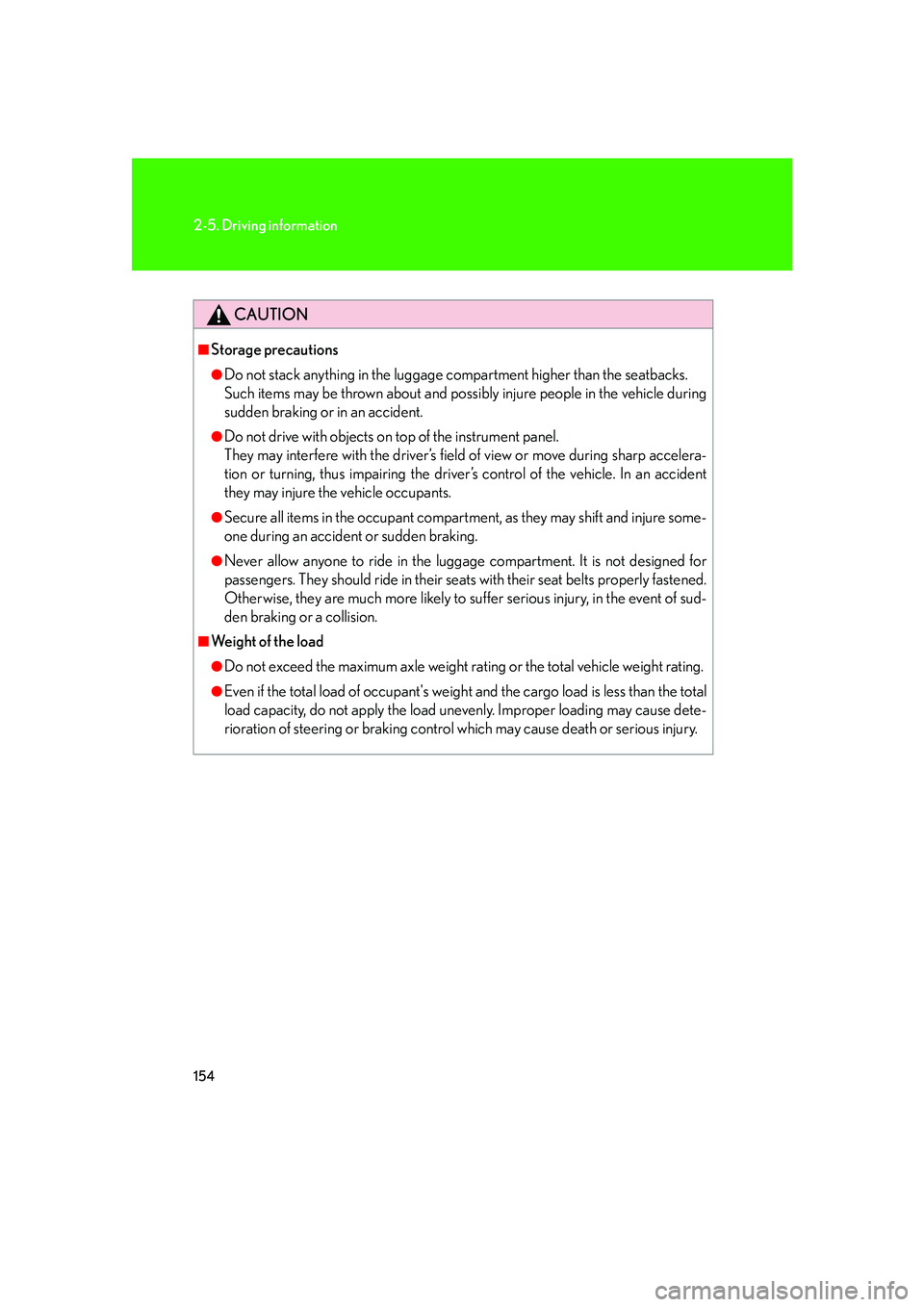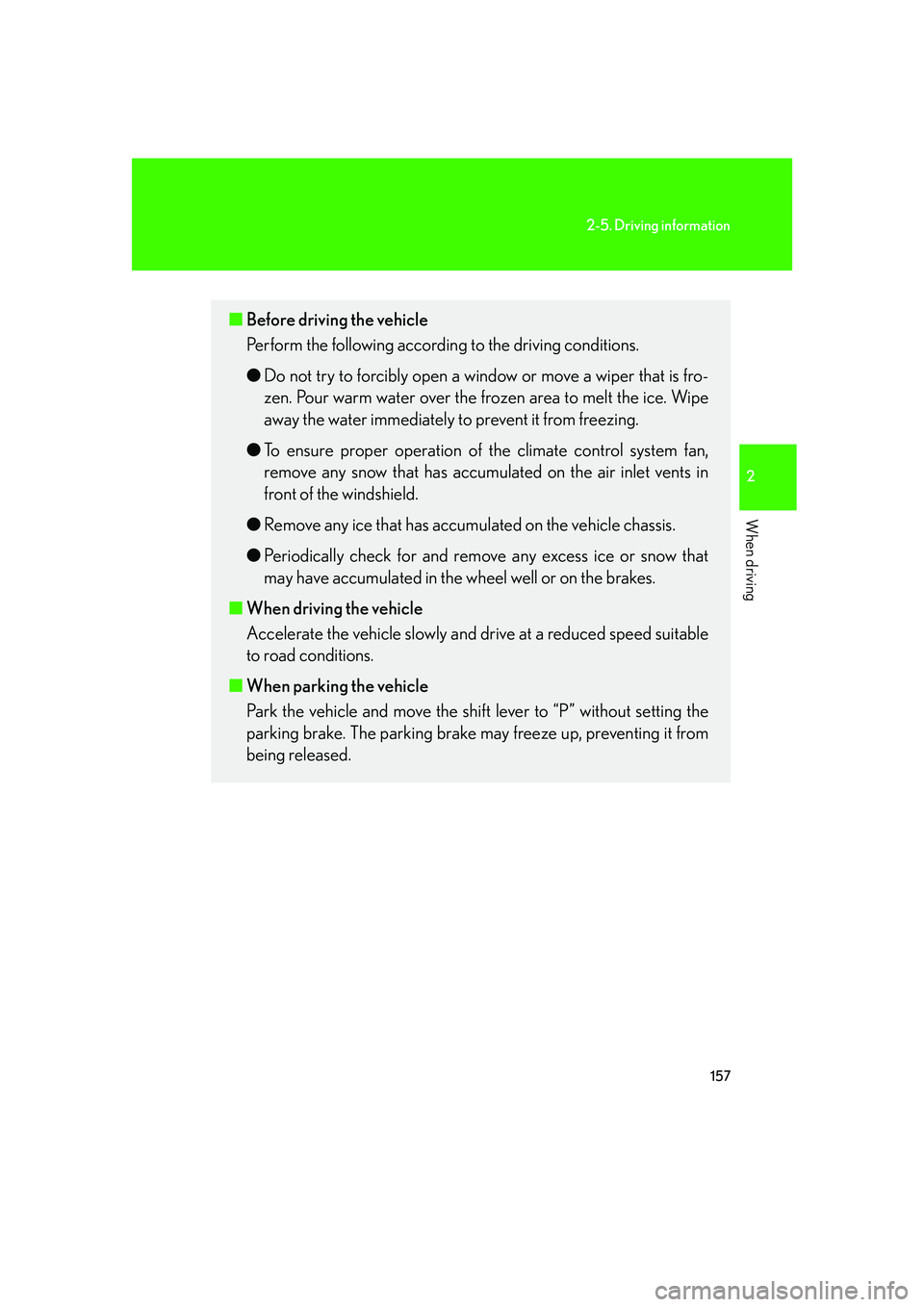LEXUS LX470 2007 Owners Manual
Manufacturer: LEXUS, Model Year: 2007, Model line: LX470, Model: LEXUS LX470 2007Pages: 426, PDF Size: 10.95 MB
Page 171 of 426

153
2-5. Driving information
2
When driving
Seating configuration variationCargo capacity
Weight of removed third seat
When removing the third seat, it is pos sible to load as much cargo as the
weight of the removed seat.
(Cargo capacity) = (Total load capaci ty) - (Total weight of occupants) +
(Weight of the removed third seat).
Third seat weight:
Right 44 lb. (20 kg)
Left 44 lb. (20 kg)
Page 172 of 426

154
2-5. Driving information
CAUTION
■Storage precautions
●Do not stack anything in the luggage compartment higher than the seatbacks.
Such items may be thrown about and possibly injure people in the vehicle during
sudden braking or in an accident.
●Do not drive with objects on top of the instrument panel.
They may interfere with the driver’s field of view or move during sharp accelera-
tion or turning, thus impairing the driver ’s control of the vehicle. In an accident
they may injure the vehicle occupants.
●Secure all items in the occupant compartment, as they may shift and injure some-
one during an accident or sudden braking.
●Never allow anyone to ride in the luggage compartment. It is not designed for
passengers. They should ride in their seat s with their seat belts properly fastened.
Otherwise, they are much more likely to suffer serious injury, in the event of sud-
den braking or a collision.
■Weight of the load
●Do not exceed the maximum axle weight ra ting or the total vehicle weight rating.
●Even if the total load of occupant's weight and the cargo load is less than the total
load capacity, do not apply the load unevenly. Improper loading may cause dete-
rioration of steering or braking control which may cause death or serious injury.
Page 173 of 426

155
2-5. Driving information
2
When driving
Vehicle load limits
■Total load capacity and seating capacity
These details are also described on the tire and loading information label.
( P. 3 0 2 )
CAUTION
■Overloading the vehicle
Do not overload the vehicle.
It may not only cause damage to the tire s, but also degrade steering and braking
ability, resulting in an accident.
Vehicle load limits include total lo ad capacity, seating capacity, towing
capacity and cargo capacity.
■ Total load capacity: 1200 lb. (545 kg)
Total load capacity means the comb ined weight of occupants, cargo
and luggage.
■ Seating capacity: 8 occupants (Front 2, Rear 6)
Seating capacity means the maximu m number of occupants whose
estimated average weight is 150 lb. (68 kg) per person.
Even if the number of occupants ar e within the seating capacity, do
not exceed the total load capacity.
■ Towing capacity: 6500 lb. (2948 kg)
Towing capacity means the maximu m gross trailer weight (trailer
weight plus its cargo weight) that you vehicle is able to tow.
■ Cargo capacity
Cargo capacity may inc rease or decrease depending on the weight
and the number of occupants.
Page 174 of 426

156
2-5. Driving information
Winter driving tips
Carry out the necessary preparations and inspections before driving the
vehicle in winter. Always drive the vehicle in a manner appropriate to the
prevailing weather conditions.
■ Pre-winter preparations
●Use fluids that are appropria te to the prevailing outside tempera-
tures.
• Engine oil
• Engine coolant
• Washer fluid
● Have a service technician inspect the level and specific gravity of
battery electrolyte.
● Have the vehicle fitted with four snow tires or purchase a set of
tire chains for the rear tires.
Ensure that all tires are the same size and brand, and that chains match
the size of the tires.
Page 175 of 426

157
2-5. Driving information
2
When driving
■Before driving the vehicle
Perform the following according to the driving conditions.
● Do not try to forcibly open a w indow or move a wiper that is fro-
zen. Pour warm water over the frozen area to melt the ice. Wipe
away the water immediately to prevent it from freezing.
● To ensure proper operation of the climate control system fan,
remove any snow that has accumu lated on the air inlet vents in
front of the windshield.
● Remove any ice that has accumul ated on the vehicle chassis.
● Periodically check for and remove any excess ice or snow that
may have accumulated in the wheel well or on the brakes.
■ When driving the vehicle
Accelerate the vehicle slowly and dr ive at a reduced speed suitable
to road conditions.
■ When parking the vehicle
Park the vehicle and move the shift lever to “P” without setting the
parking brake. The parking brake may freeze up, preventing it from
being released.
Page 176 of 426
![LEXUS LX470 2007 Owners Manual 158
2-5. Driving information
Selection tire chainsUse the correct tire chain size when mounting the snow chains.
Chain size is regulated for each tire size.
Side chain
(3.5 mm [0.14 in.] in diameter LEXUS LX470 2007 Owners Manual 158
2-5. Driving information
Selection tire chainsUse the correct tire chain size when mounting the snow chains.
Chain size is regulated for each tire size.
Side chain
(3.5 mm [0.14 in.] in diameter](/img/36/58005/w960_58005-175.png)
158
2-5. Driving information
Selection tire chainsUse the correct tire chain size when mounting the snow chains.
Chain size is regulated for each tire size.
Side chain
(3.5 mm [0.14 in.] in diameter)
Cross chain
(4 mm [0.16 in.] in diameter)
Regulations on the use of snow chains● Regulations regarding the use of tire chains vary according to location
and type of road. Alwa ys check local regulations before installing
chains.
● Retighten the chains after driving 1 /4 - 1 /2 mile (0.5 - 1.0 km).
■Snow chain installation
Observe the following precautions when installing and removing chains.
●Install and remove tire chains in a safe location.
●Install tire chains on the rear tires.
●Install tire chains following the inst ructions provided in the accompanying
instructions.
Page 177 of 426

159
2-5. Driving information
2
When driving
CAUTION
■Driving with snow tires
Observe the following precautions to reduce the risk of accidents.
Failing to do so may result in a loss of vehicle control and cause death or serious
injury.
●Use tires of the size specified for your vehicle.
●Maintain the specified level of tire inflation pressure.
●Do not drive in excess of 75 mph (120 km/h), regardless of the type of snow tires
being used.
●Snow tires should be installed on all wheels.
■Driving with snow chains
Observe the following precautions to reduce the risk of accidents.
Failing to do so may result in the vehicle being unable to be driven safely, and may
cause death or serious injury.
●Do not drive in excess of the speed limit specified for the tire chains being used,
or 30 mph (50 km/h), whichever is lower.
●Avoid driving on bumpy road surfaces or over potholes.
●Avoid sudden turns and braking, as use of chains may adversely affect vehicle
handling.
●Slow down sufficiently before entering a curve to ensure that vehicle control is
maintained.
NOTICE
■Repairing or replacing snow tires
Request repairs of and obtain replacement snow tires from Lexus dealers or legiti-
mate tire retailers.
This is because the removal and attachment of snow tires affects the operation of
the tire pressure warning valves and transmitters.
■Fitting tire chains
The tire pressure warning valves and transmitters may not function correctly when
tire chains are fitted.
Page 178 of 426

160
2-5. Driving information
Trailer towing
Your vehicle is designed primarily as a passenger-and-load carrying vehi-
cle. Towing a trailer will have an adverse effect on handling, performance,
braking, durability, and fuel consumpt ion. For your safety and the safety of
others, do not overload the vehicle or trailer.
Lexus warranties do not apply to damage or malfunction caused by towing
a trailer for commercial purposes.
■ Weight limits
Confirm that the total trailer weight , gross vehicle weight, gross axle
weight and trailer tongue lo ad are all within the limits.
■ Gross vehicle weight
The gross vehicle weight must no t exceed the Gross Vehicle Weight
Rating (GVWR) indicated on the Certification Label. The gross
vehicle weight is the sum weight of the unloaded vehicle, driver, pas-
sengers, luggage, hitch and trail er tongue load. Also included is the
weight of any special equipment installed on your vehicle.
■ Gross axle weight
The load on either the front or rear axle resulting from distribution of
the gross vehicle weight on both axles must not exceed the Gross
Axle Weight Rating (GAWR) lis ted on the Certification Label.
Certification Label
Page 179 of 426

161
2-5. Driving information
2
When driving
Towing a trailerContact your Lexus dealer for furt her information about additional
requirements such as a towing kits, etc.
Hitch
Trailer hitch assemblies have differen t weight capacities established by
the hitch manufacturer. Even though the vehicle may be rated for tow-
ing a higher weight, the operator must never exceed the maximum
weight rating specified for the trailer hitch.
■ Trailer tongue load
The trailer cargo load should be d istributed so that the tongue load
is 9 to 11% for weight carrying hitch or 15% for we ight distributing
hitch of the total trailer weight, not exceeding the following.
Weight carrying hitch: 650 lb. (295 kg)
Weight distributing hitch: 975 lb. (442 kg)
(Tongue load/ Total trailer weight x 100 = 9 to 11% or 15%)
The total trailer weight and tongue load can be measured with plat-
form scales found at a highway we ighing stations, building supply
companies, trucking companies, junk yards, etc.
Total trailer weight
Tongue load
Page 180 of 426

162
2-5. Driving information
Selecting trailer ballUse the correct trailer ball for your application. Trailer ball load rating
Matches or exceeds the gross
trailer weight rating of the trailer.
Ball diameter
Matches the size of the trailer cou-
pler. Most couplers are stamped
with the required trailer ball size.
Shank length
Protrudes beyond the bottom of
the lock washer and nut at least 2
threads.
Shank diameter
Matches the ball mount hole diam-
eter size.